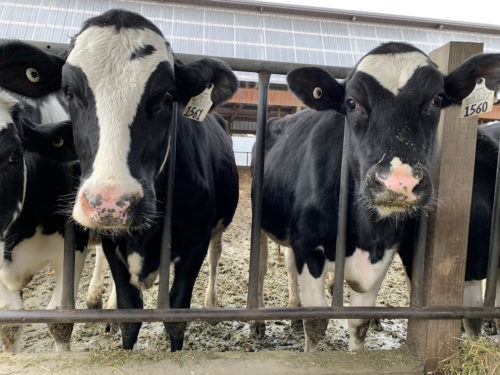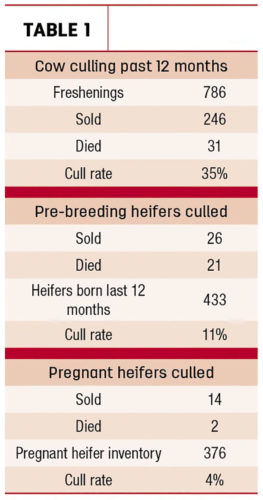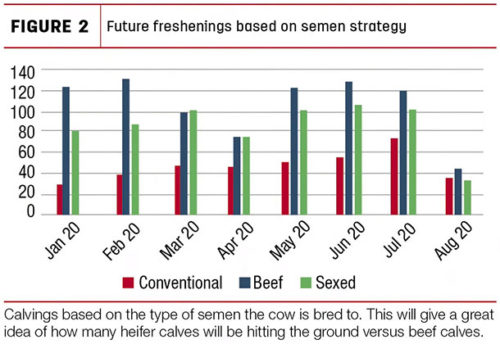Unlocking your heifer inventory goals
Posted: January 8, 2021 | Written By: Megan Weigel, Form-A-Feed nutrition and production specialist

Article originally published March 11, 2020 for Progressive Dairy.
There are many topics to discuss when managing heifer inventory. Producers give careful thought to feed and labor costs, reproduction, semen strategies, etc. – the list can go on and on.
While these are all excellent areas of focus, have you ever considered how many replacements are needed for your operation? Reviewing key indicators like cull rate, current inventory and projected freshenings may help unlock your heifer replacement goals before heifers are even born.
Cow cull rate
 A good place to start is cow removal or cull rate. In the last 12 months, how many cows were voluntarily and involuntarily culled from the farm? Starting here will give you a general idea of how many replacements should be retained. Consider trends when looking at removal rate to determine consistency. Cull rates tend to stay steady year after year unless there is a major change in strategy or unforeseen circumstances. A general recommendation is to review changes in cull rate on a monthly basis to get a better sense of when and why cows are leaving the herd and whether seasonality has any effect (Table 1).
A good place to start is cow removal or cull rate. In the last 12 months, how many cows were voluntarily and involuntarily culled from the farm? Starting here will give you a general idea of how many replacements should be retained. Consider trends when looking at removal rate to determine consistency. Cull rates tend to stay steady year after year unless there is a major change in strategy or unforeseen circumstances. A general recommendation is to review changes in cull rate on a monthly basis to get a better sense of when and why cows are leaving the herd and whether seasonality has any effect (Table 1).
Heifer cull rate
Another area to consider is heifer removal rate based on age and pregnancy. It helps to have an understanding of how many young prebreeding heifers are leaving the herd as well as the removal rate for pregnant heifers. Keep in mind that the bred heifer cull rate not only considers the heifer as a replacement but the calf as a potential replacement as well. A good rule of thumb is to divide the youngstock into two groups: heifers culled prebreeding age and younger for the first group and pregnant heifers in the second group. This also gives the farm a better understanding of when youngstock are leaving the herd and may provide a hidden opportunity to improve management.
Live heifer inventory
After reviewing the cull rate and having a better understanding of how many heifers and cows are leaving the herd, take some time to review the live heifer inventory on your farm. Assessing heifers by age in months will give a good indication of what the herd will look like over time. It will also provide a better understanding of stocking density. If you have an abundance of young heifers, will you have enough time and space to get those heifers pregnant once they enter the breeding pen?
Taking the pressure off stocking density will help producers stay closer to their goals, like age in months at first breeding and freshening. You could approach this question by first examining the springers that are needed to enter the herd on a month-to-month basis, built off of the cow cull rate, then the cull rate of the youngstock leaving the herd. Keeping in mind that these numbers can fluctuate, it would be wise to keep an additional 5% to 10% more heifers beyond your needs in case of unforeseen circumstances.
Future freshenings by month
Reviewing projected freshenings by month is a great way to manage your replacement inventory (Figure 1).
Determining how many replacements you need per month can help you make culling decisions on the youngstock that will soon be entering the herd. Some months may have as much as double the amount of heifers you need to freshen. Having a plan for your maternity pen as well as calf barn will help make the transition smoother if you are aware of what is coming. When looking at future freshenings, also make sure to consider the sire.
Maybe you have room to freshen in more heifers but, if they are bred to sexed semen, you may want to consider how much room is available in your calf barn (Figure 2).
Heifers born by month
The more data you have, the better picture you will have of your future herd. Once you have taken the time to assess your cull rates for both cows and heifers, your live heifer inventory and your future monthly freshenings, you can take your analysis one step further by looking at projected heifer calves born by month.
Review the percent heifer calves born in the past 12 months based on semen type and usage. Review how many heifers you currently have bred to sexed semen as well as beef semen and consider how this will affect the future of the herd when those animals freshen. Also consider your DOA (dead on arrival) rate. Conducting an ultrasound to determine the sex of the calf provides an additional advantage. This information will allow you to anticipate the number of heifer calves that will be born from month to month.
Paying close attention to trends within the herd and capturing as much data as possible will help you get closer to generating the desired amount of replacements. It will also support your long-term goals and provide a strong understanding of the future of your herd.

